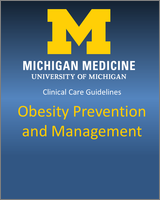| Diet and eating: avoid high calorie, low nutrient foods |
Eat a variety of nutritious foods. Encourage and support breastfeeding during infancy.
Emphasize:Fruits and vegetables – at least 5 servings per day. Whole grains – look for 100% whole grain and at least 3 grams of dietary fiber per serving. Fat-free or low-fat milk and dairy products. If lactose-intolerant, choose fat-free lactose-free milk, or fat-free plain soy, almond, or rice milk. Lean meats, skinless poultry, fish, beans, soy products, eggs, and nuts. Bake, broil, steam, or grill. Avoid frying foods. Low saturated fats (look for 5% or less on the nutrition facts label). Consider using plant-based oils such as olive oil for cooking, instead of margarine or butter. Stay within your daily calorie needs or use the plate method to control caloric intake.
|
Eliminate or Reduce:Foods high in saturated fat include fatty meats (eg, bacon, sausage, deli meats, hot dogs), fried foods, full fat dairy products, donuts, cookies, ice cream. High calorie beverages: sugar-sweetened beverages (regular soft drinks, fruit drinks, fruit punch, sweet tea, sweetened coffee drinks) and alcoholic beverages. High calorie and low nutrient foods: sweets and junk food such as chips. Avoid fast food, and limit eating out to rare occasions. When eating out, choose grilled or baked fish or chicken, steamed vegetables without butter, salads with low-fat dressing on the side. If eating fast food, select a grilled chicken sandwich or veggie burger and a side salad with low-fat dressing on the side. Avoid French fries and other fried foods.
|
Address environmental and family factors associated with eating:Reduce portions. Use smaller plates. Measure or weigh portions. Schedule food consumption. Schedule regular times to eat within a limited time window during the day. Shortening the time window from 12 hours down to 8 hours may be helpful. Avoid excessive snacking. Help adults increase children’s healthy eating. Promote family meals. Limit eating out and avoid fast food. Limit young children’s screen time and exposure to food and beverage marketing. Shop the outside perimeter of the typical grocery store to obtain the basic food groups. Limit the purchase of packaged, highly-processed, and convenience foods. Read food labels and select low-fat, high-fiber, and low-sodium foods. Choose foods with less than 5 grams of fat per serving. Choose foods with 5 grams or more of fiber per serving. Limit sodium to 300 mg per serving. Be aware that advertising can be deceptive. Low-carbohydrate and low-fat messaging does not necessarily translate into reduced calories. Review labels for calorie content.
|
